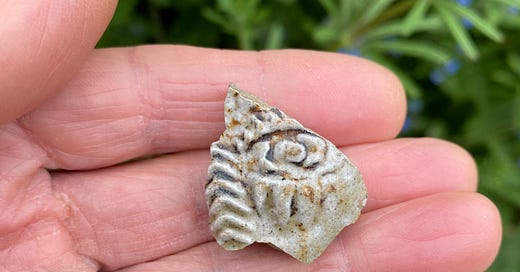Found looking up at me in a field: a post-medieval pottery sherd.
A warm hello to you, between the moons friends.
Here is Part 2 of my writing about Rogationtide. Well, more specifically about the art project that was inspired by the enthusiastic celebration of this May-tide festival during the time that Norfolk’s many medieval churches were being raised from the chalk and the flint.
If you missed Part 1 which tells a little about the practice of the traditional three-day Rogationtide perambulation - sometimes called Beating the Bounds - you’ll find it in Charming the Fields. In this post I also explained how the festival is essentially a lunar one, calculated as it is by the date on which Easter falls on any given year, which in turn is calculated according to the timing of the first full moon following the Spring Equinox.
My Rogationtide project was part of a year-long residency in Wood Dalling’s medieval church (set up by me, not invitational) and I chose this festival as the very first of the 12 I had planned to work with as the wheel turned. That’s the one I wrote about in Charming the Fields, and I found that once I began my research - always a fun part for me - the ideas for my own vision of what it might mean to take care of any given area of land and keep its bounds healthy began to flow.
I enjoyed it so much, in fact, that when the year came to an end and the 12 originally-planned church festivals had come and gone, I decided that it would not be stretching things too far to repeat the Rogationtide perambulation again to complete the project with a magical 13. This, I felt, also had a resonance with the idea of the ‘year and a day’ of fairy tales.



